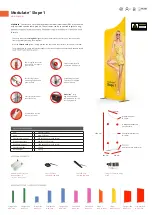
English – Inglés – Anglais
3.2.2.- General observations related to
sites
The location of the tower will be made
preferably on a firm base with two possible
alternatives:
a) Layout on concrete.
b) Layout on steel support.
Figures 16, 17, 17 and 19 show the different
possible layouts, according to tower model.
The place selected as the tower site is very
important for the tower maintenance and control
to be made afterwards. To this effect it is
important to take into account a good access
any of the elements belonging to the tower
(motor, fan, water distribution system, etc.,) for
the eventual servicing and repairs. If the
to the site is difficult, the assembly,
control will be also difficult to implement
a) If the rooftop, upper part of a building or
elevated structure are the only acceptable
locations, it is of utmost importance
an easy access to the elements
by means of ladders, structures, etc.
b) Taking into account the unavoidable ice
formations around the tower during winter
service, it is important not to locate
near the roof edge or beside vehicles ramps.
c) Potentially carrying droplets air discharge
must neither take place straight of an air
inlet, nor straight of an opening. The
discharge points must be designed in order
to avoid suction of air loaded of droplets in
ducts of neighboring buildings and inside
courts.
The equipment must be located at a
minimum distance of 8 meters of all
openings on an occupied premise.
Anglais
General observations related to tower
The location of the tower will be made
on a firm base with two possible
show the different
possible layouts, according to tower model.
The place selected as the tower site is very
important for the tower maintenance and control
to be made afterwards. To this effect it is
good access to
any of the elements belonging to the tower
(motor, fan, water distribution system, etc.,) for
the eventual servicing and repairs. If the access
to the site is difficult, the assembly, servicing and
implement.
If the rooftop, upper part of a building or an
elevated structure are the only acceptable
locations, it is of utmost importance to create
an easy access to the elements mentioned
structures, etc.
unavoidable ice
formations around the tower during winter
service, it is important not to locate the tower
vehicles ramps.
Potentially carrying droplets air discharge
must neither take place straight of an air
ight of an opening. The
discharge points must be designed in order
to avoid suction of air loaded of droplets in
ducts of neighboring buildings and inside
The equipment must be located at a
minimum distance of 8 meters of all
ed premise.
Français– French
3.2.2.- Observations générales pour
l’implantation des tours
L´emplacement de la tour sera réalisé
préférablement sur un sol ferme, avec deux
possibles alternatifs:
a) Disposition sur bêton.
b) Disposition sur support métallique.
Les possibles dispositions selon le modèle
la tour sont montrées sur les figures 1
19.
Le site choisi pour son emplacement, est
décisif pour le fonctionn
postérieur et le contrôle de la tour.
doit tenir compte de la facilité d´accès
n´importe quel élément qui la constitue,
ventilateur, système distributeur
de possibles révisions et
est montée dans un lieu
connexion et la réalisation
difficiles.
a) S´il n´existe pas d´autre lieu plus approp
pour l´emplacement que le toit, la
supérieure d´un bâtiment, une
élevée, etc., il est indispensable
possibilités nécessaires
accès
facile
les
antérieurement,
par
passerelles, etc.
b) Compte tenu des inévitables formations
glace autour de la tour, pendant le
fonctionnement en hiver, on calculera à
pas placer celles-ci totalement au
toits, ou à côté de rampes pour
c) Les rejets d’air potentiellement chargé
d’aérosols ne seront effectués ni au droit
d’une prise d’air, ni au droit d’ouvrants. Les
points de rejets seront aménagés de façon
éviter
l’aspiration
de
l’air
chargé
de
gouttelettes dans les conduits de ventilation
d’immeubles
avoisinants
ou
les
cours
intérieures.
L’installation sera implantée à une distance
minimale de 8 mètres de toute ouverture sur
un local occupé (selon la norme NF E 38
Pag. 20
French –Francés
Observations générales pour
l’implantation des tours
L´emplacement de la tour sera réalisé
sur un sol ferme, avec deux
a) Disposition sur bêton.
support métallique.
Les possibles dispositions selon le modèle de
la tour sont montrées sur les figures 16, 17, 17 et
Le site choisi pour son emplacement, est
nement correct, l´entretien
postérieur et le contrôle de la tour. À cet effet, on
doit tenir compte de la facilité d´accès à
n´importe quel élément qui la constitue, (moteur,
ventilateur, système distributeur d´eau, etc.) pour
de possibles révisions et réparations. Plus la tour
lieu inaccessible, plus la
connexion et la réalisation des opérations seront
S´il n´existe pas d´autre lieu plus approprié
acement que le toit, la partie
supérieure d´un bâtiment, une structure
élevée, etc., il est indispensable de créer les
nécessaires pour atteindre par un
accès
facile
les
éléments
décrits
antérieurement,
par
moyen
d´escaliers,
Compte tenu des inévitables formations de
glace autour de la tour, pendant le
fonctionnement en hiver, on calculera à ne
ci totalement au bord des
toits, ou à côté de rampes pour véhicules.
Les rejets d’air potentiellement chargé
ont effectués ni au droit
d’une prise d’air, ni au droit d’ouvrants. Les
ont aménagés de façon à
éviter
l’aspiration
de
l’air
chargé
de
gouttelettes dans les conduits de ventilation
d’immeubles
avoisinants
ou
les
cours
implantée à une distance
minimale de 8 mètres de toute ouverture sur
un local occupé (selon la norme NF E 38-424)
















































